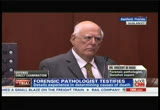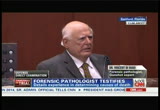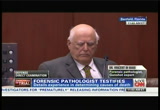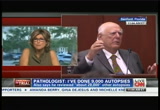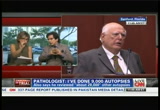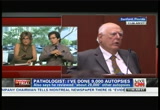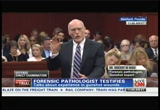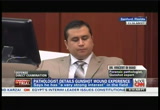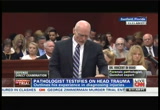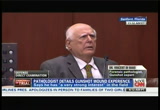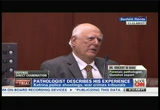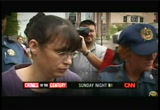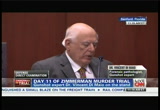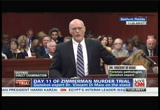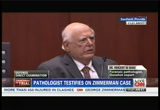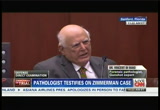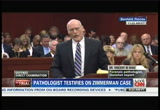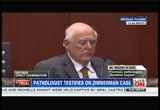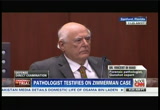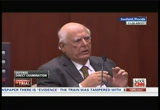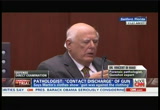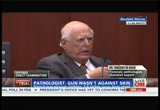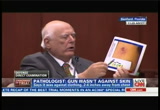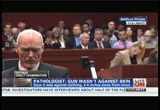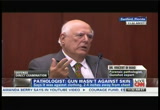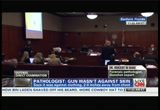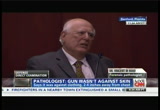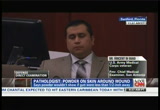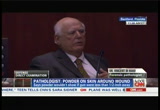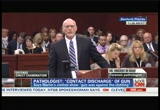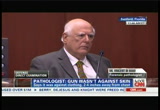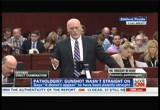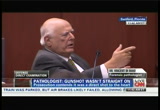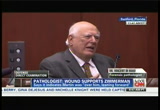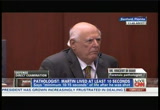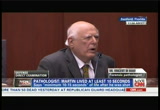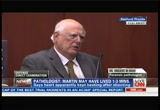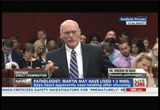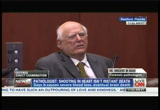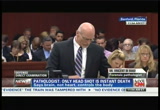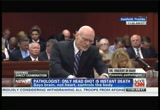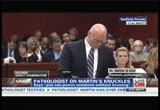tv CNN Newsroom CNN July 9, 2013 11:00am-12:00pm EDT
11:00 am
were developed over the time that you've worked as a forensic pathologist. >> right, over 40 years. >> you mentioned that you had worked in bexar county, as the medical examiner, from 1981 until the end of 2006. during that time, did you routinely perform autopsies? >> yes, i performed about 9,000 autopsies and then i reviewed the autopsies that were done under my jurisdiction, and that was about at 27,000, 28,000. read the autopsies and said whether i agreed or not. and the 9,000, i did autopsies until act of the year that i retired. >> would you typically, if involved in a criminal case,
11:01 am
involving work that you had done be called by the prosecution? >> yes. yes. you know, of course, if i was medical examiner, i would testify in court about the autopsies i did and the other doctors testified about the autopsies that they did. >> meaning that you had a staff of other forensic pathologists at your medical examiner's office that also performed autopsy? >> i had four full-time physicians, plus i had one training physician. our office, my office, former office, was approved for a program to train fellows in the field of forensic pathology. there was, i think, about 38, 39 offices in the united states approved to train in forensic pathology. >> during the time that you were there, for lack of a better term, a ballpark idea of how
11:02 am
many autopsies the office would do in the course of a year. >> oh, we do 14 to 1,500 autopsies, i would say, and then we'd have about another equal number of 14 to 1,500 bodies that we elected, not to do autopsies, just external ones. >> and you would, yourself, perform autopsies throughout the time that you were there? >> right. i think the last autopsy i did was in october and then i retired in december. you can't work until the last day, because it takes weeks, if not a month or two, to complete all the details of an autopsy. so you have to stop a couple of months before. >> since 1981, when you began your work at the bexar county medical examiner's office, were you also able to work as a consultant privately in other cases, outside bexar county? >> yes, sir. >> and what kind of work would
11:03 am
you do that in regard? >> mostly civil cases and then a few criminal cases. outside bexar county, i could testify for the defense. you don't do many private criminal cases, such as like i'm doing now. i run about two to four a year, at most. >> you have been working as a consultant since the beginning of 2007, then, if i've done the math correctly -- i'm sorry, exclusively as a consultant, having retired from the medical examiner's office. >> since january of 2007. >> in other words, you've been in private practice as a consultant since january of 2007. >> yes, sir. >> and the majority of your work is in connection with civil cases? >> yes, sir. >> does that sometimes still
11:04 am
include gunshot injuries, though? >> yes. usually it's cases -- insurance cases involving alleged suicides, whether the case is a suicide or not. occasionally you'll get a case of accidental discharge to maybe a defect in the firearm. >> so, real quickly, i just want to let you know what it is you're watching here with this brand-new witness, back up on the stand. second day of the week, vincent di maio is a legend. this guy has been in more trials than have been on television. last big, big one as i recall, was phil spector. this is the medical examine formally from bexar, texas, knows a thing or two about autopsy, packaging up evidence after an autopsy. mark nejame joins me here. you know a lot more about why
11:05 am
you use an m.e. when you're in a defense case and what they want out of this witness. >> this is the guy that wrote the book. >> literally. >> his book is called "forensic pathology," and it's getting ready to go into its third edition. he was appointed by governor rick scott of texas to head up a all forensic labs in the state of texas. this is the guy -- >> not governor rick scott, rick perry. >> excuse me, rick scott's your governor in florida. >> listen, he is a great expert witness. he's used all over the place. he almost could get up on the stand and say, let's just bypass all the credentials. >> especially in contrast from what we've heard from the m.e. in seminole county. now the jury is going to hear the m.e. from seminole county who have performed a couple dozen. >> quick checklist, distance of the bullet? he's going to hit this? >> anything they talked about with the first m.e. -- >> trajectory of the bullet, angle or straight ahead. >> the first m.e. said, from inches to a few feet. so this will also provide a bit
11:06 am
of a foundation to the information the state's -- the defense is trying to put in. >> real quick, real quick. they already touched on packaging. you put it in plastic, it stinks to high heaven and degrades. and we had testimony, and it seemed the m.e. was really uncertain as to whether it put into plastic or paper, but we know the people who received the evidence from the autopsy, it was in -- >> plastic. but even the m.e. said, if anybody put it in plastic, they should lose their job. they should be fired. that was the seminole county m.e. who said it would never be going in plastic. and lo and behold, we know it was put in plastic. >> so here's the deal, even though he's a legend and we all know how great he is and we've watched him in many a trial, they're still not talking necessarily about this particular case. you're not missing anything. they're establishing his creds. he's got a lot of them, but you've got to get it on the record. we're going to fit in a quick break so you don't miss any of his testimony as it relates to the case against george zimmerman. we're back live from sanford after this. ordinary rubs don't always work on my arthritis.
11:09 am
try capzasin-hp. it penetrates deep to block pain signals for hours of relief. capzasin-hp. take the pain out of arthritis. welcome back live in sanford, florida, at the seminole county criminal justice center. i'm ashleigh banfield reporting live on the george zimmerman murder trial. witness number one in front of the jury, anyway, is dr. vincent di maio. he's on the stand and this guy wrote the book about csi and forensic pathology. let's see where he gets and how far he gets. let's go live. >> followed by the bullet and then followed by the soot or the burning powder behind it. >> right. and that's why blanks, people think blank cartridges are dangerous -- are not dangerous.
11:10 am
you can kill yourself with them. if you take a gun with a blank cartridge and put it against your chest, the gas formed will just tear right through your skin and muscle into your lung. and people, you know, kid around and will put it to their head. they could die. it goes right in -- you don't need the bullet to kill you with contact wounds. >> let's continue, though, with some of your experience and some of your writings. have you written any articles about head trauma, in particular? >> yes, i wrote one peer-reviewed article and then i've written a chapter in my book on forensic pathology, on head injuries. >> head injuries, meaning such thing as blunt force trauma to the head? >> right. >> i think you mentioned that
11:11 am
you also have served as an editor of peer-reviewed scientific journals. >> yes, i'm the editor in chief of the american journal of forensic medicine and pathology. >> does that work include whether or not to accept a submission for, by a research, for publication. >> yes, i have the final say. i receive the articles, they go out to reviewers, their reports come back to me, and then i read the reviews and decide whether to publish or not. >> let's talk about work that you may have done, specifically for entities outside the bexar county medical examiner. with reference to your expertise in firearms injuries, particular, have you done work for the united states government? >> yes, about, i think about two years ago, i testified for the
11:12 am
u.s. attorney's office and some incidents in new orleans, during the hurricane katrina, where police officers shot and wounded a number of people and killed one person. and i testified for the u.s. department of justice in that case. and i have done like one or two other cases and such. >> have you done any work for the united states marines? >> war crimes, i testified for marine corps in the prosecution of an individual charged with war crimes. >> how about for the british government? >> pardon? >> for the british government? >> the bloody sunday massacre, that happened in belfast years and years ago. and the -- and i have another case going in about another two
11:13 am
months in britain, having to do with actually concussion head injury. >> as well the united nations? >> yes. yugoslavia war crimes, the autopsies, who therm valid or not. >> and let's talk briefly about some of the jurisdictions in which you've testified as an expert in forensic pathology. >> i've testified in most states in the union. state courts, federal courts, testified in canada, colombia, south america, by video. i was able to testify, you know, by the computer and everything. let's see, south africa, israel.
11:14 am
>> i don't believe we've touched upon -- and that's in the united states in both state and federal courts? >> yes, sir. >> have you received some professional awards as well? >> yes, sir, from, my medical school gave me the master teacher award, and then i got some outstanding service awards from the national association of medical examiners, the milton hepburn awards from the american academy of sciences. [ male announcer ] this is betsy.
11:15 am
11:17 am
so we're two days into this week, likely possibly the last week of testimony in this case. we could be wrapping this thing up by the end of the week, if you can believe it. or maybe you can, because you've been gavel-to-gavel on this, and that means you'll know what this picture is. it's side bar. mics are off, the courtroom hears static at this time. but on tv, you get to at least get a little perspective on what's been going on and what's coming. faith jenkins and danny cevallos are those two experts who also join me live on this. faith jenkins, since you're the former prosecutor and current defense attorney, tell me this, my friend. when you get an m.e. who's going through his creds and he's about to go into the nitty-gritty of molecular science, how do you as a lawyer keep the jury intrigued and listening, because the devil is in these details. and if you get sleepy, you lose these things. >> well, jurors in murder cases,
11:18 am
ashleigh, typically tend to be very riveted by this kind of testimony, because it is really the mechanics here, and what's involved with a gunshot wound and a bullet wound. so you're going to hear dr. di maio testify about the specifics of this. and both sides have testified about how far the gun was from trayvon martin. this testimony is key. i think the jurors know that, so they'll be honed in on that. >> danny cevallos, ten seconds. same question. >> this is always riveting testimony and it's really going to be like always, a battle of the experts. jury ultimately decides. >> amen to that. well, this is a great expert. let's continue to listen to his direct examination and see where they're going first with what they need out of this witness. vincent di maio, m.e.
11:19 am
>> doctor di maio, let's turn to the work that uh yo did specifically in this case. >> yes, sir? >> would you describe the materials that you have received for review in this case, and if you have notes, reflecting some of that information, that you want to refer to, you're welcome to do that. copies have been provided to the state, but just feel free to use your notes if you wish. >> yes, sir. the material they reviewed were scene photos taken by the police and the medical examiner investigators, photographs of mr. zimmerman by the police and some civilians. the autopsy report, including toxicology and autopsy photos. the medical records of the ems and a clinic regarding mr. zimmerman. a witness statement and a
11:20 am
transcribed conversation, given by mr. john good. 911 calls, a reenactment tape of the incident by mr. zimmerman. dna reports, a firearm examiner reports, and the deposition of dr. rao. >> what i would like to talk with you about, in terms of your findings -- well, let me ask you first. you did have an opportunity to review the video recording of mr. zimmerman, in that sense, reenacting the events immediately surrounding the shooting? >> yes, sir. >> and you've had access to some witness statements?
11:21 am
>> yes, sir. >> have you, to your knowledge, reviewed all of the witness statements? >> no, i haven't, because by the nature of this case, it's more about determining whether the physical evidence is consistent with mr. zimmerman's account, what he says happened. because the witness statements tend to be, in most cases, all around, you know, vary greatly. so the easiest way to hear it is to evaluate the physical evidence that you have on the body, and the clothing and such, and then compare it to the statements of the defendant, in this case, mr. zimmerman, and see whether they are consistent. you know, if you say that the bullet came in the front and the bullet came in the back, well, obviously, they're inconsistent. so that's what you're essentially doing in this case.
11:22 am
>> and in doing that, in this case, would you look at, in addition to what mr. zimmerman said happened on the video reenactment, you would look at the forensic evidence, which includes the pictures from the autopsy, that might show the gunshot wound. >> right. >> would that include looking at the report from the firearms expert, who analyzed the clothing? >> that's correct. the two most important things in this case are the autopsy report, including the photographs of the wound, and the reports by the firearms examiner. and then, secondarily, the scene photographs and such. but what you're looking at mostly is the autopsy and the very detailed and excellent
11:23 am
report by the firearms examiner. >> so would your analysis include, for example, trying to reach an opinion as to the distance between the end of the barrel and the skin? >> yes, sir. >> would it also include trying to reach an opinion from the end of the barrel to the clothing? >> yes, sir. >> trying to reach an opinion, what effect, if any, the clothing may have had in the appearance of the wound on the skin? such things as that? >> yes, sir. >> we'll talk about some of those details in a moment. but some of the things that i would also like to talk with you about today is your opinion of how long trayvon martin may have been alive. and also, how long trayvon martin may have been conscious, if those are different opinions. >> they're different opinions, because you can be alive and
11:24 am
unconscious. so, right, they're two separate things. >> we'll talk about that more. i also want to ask you some questions about the injuries that mr. zimmerman sustained that are reflected in the photographs taken by the sanford police department. did you have access to those photographs and the chance to review them? >> yes, sir, i did. >> i'll also want to talk with you a little about the injuries that you observed through photographs or through reviewing the autopsy, sustained by trayvon martin, in addition to the gunshot wound itself. so generally, that's the framework of what i would like you to talk about today. and let's more specifically talk about the gunshot itself.
11:25 am
and the mechanics involved in that. i know you've already touched upon mechanics of what happens when a bullet is fired from a gun, when you talked about the microphotography and the that the puff of gas followed by the bullet followed by the rest of the gas is essentially the sequence? >> yes, sir. >> so let's talk about the evidence in this case. would you describe for the jury what you saw when you looked a to the photographs of the clothing that mr. martin had and the photographs of the wound to his skin and the gunshot or the tattooing that was referenced in the autopsy report. can you put all of that together for us?
11:26 am
>> yes, sir. the photographs show contact discharge of a weapon against the clothing. and this i agree 100% with the firearms examiner. at the time of the discharge, the gun was against the clothing, the gas came out, tore the clothing, there's a defect and tears from it, there's a deposit of suit all around it. so what you know is that the muzzle was in contact with the clothing at the time of discharge. and again, this is what the firearms examiner said, and also, i believe, did some experiments proving that. >> when you look at the wound in the chest, there's a different picture. the wound in the chest was about an inch to the left of the midline, half inch below the level of the nipples, and what
11:27 am
you had was a circular punched out wound, which is an entrance, but it will lay in an area of powder tattooing, measure iing inches by 2 inches. powder tattooing are marks on the skin due from powder burns that come out of the muzzle of the gun. they're not powder burns, people use the term powder burns, but it means a whole bunch of different things. this is very specific. when the powder grain comes out of the barrel and the barrel is close enough to the body, that grain of powder hits the skin and produces a mark and a reaction, a reddish color reaction, and these marks are called powder tattoo marks. some people call them, use other terms, but powder tattoo marks. they use the term stippling, but i prefer powder tattoo marks. and this indicates that a grain
11:28 am
of powder has hit the skin and a person was alive at the time. you do not get true powder tattoo marks on dead people. and there was a distribution measuring 2 inches by 2 inches. and a certain density in these tattoo marks. and this indicated that the gun was not against the skin. it was not a half inch away, it was measure an inch, and based upon the concentration of the marks, and the size of the pattern, it's my opinion that the muzzle of the gun in this case was 2 to 4 inches away from the skin. so the barrel of the gun was against the clothing, the muzzle of the gun was against the clothing, but the clothing itself had to be 2 to 4 inches away from the body, at the time
11:29 am
mr. martin was shot. >> dr. di maio, i'm going to show you what's marked as state's exhibit 96, which is a photograph taken at the medical examiner's office, showing the entrance wound. it may take a minute to warm this up, so let me, if i might approach the witness, and perhaps you can point out what you're seeing to the jury. if you look what you see is the hole produced by the bullet. that's essentially a punched out type entrance. and then all around the entrance, you see these little marks, almost like flea bites or ant bites. not fire ants, but regular ants.
11:30 am
but little bite marks, all around. and these are powder tattoo marks. and because they're red and reddish brown, that indicates the person was alive. and if you notice, there's a variation in the density, and there's a measurement of about 2 inches by 2 inches, according to the autopsy report. this cases, again, that he was alive at the time he was shot and that the muzzle was not in contact, but had to be back. the first time you see powder tattoo marks is when the muzzle is a half inch away. less than half an inch, you don't see tattoo marks. and as you begin to move the barrel away, the area of tattooing begins to get bigger and bigger and bigger. and then as it increases in range, your density will
11:31 am
decrease. this is a fairly heavy density. so you know it's, you know, less than 6 inches and such. and the density decreases, until, finally, the tattoo marks disappear. this is ball powder, most probably flattened ball. it would disappear from bare skin at about 3 feet. but by the size, the density, this is close, somewhere between 2 and 4 inches. >> your opinion as to the distance is based upon your training and research? >> yeah, i've done a lot of research in powder tattooing, and whether you can make valid judgments as to range. that is, what firearms examiners will do, they'll use like, usually, heavy white paper and they'll fire the gun, and they get a whole, and then they get marks around it.
11:32 am
and then, by the size of the pattern of the density, they'll give an opinion as to the range. well, this has been used for 75, 80 years, to make judgments. was the problem was, does it really reflect what happens on the skin? and i got curious about that, so i decided to make a determination, and i did experiments. and you have to use living animals to do it. and based on the experiments, i found out that, yes, it's valid. to determine the size of a pattern by shooting against like white paper is valid, out to at least 18 inches. so i got interested in there, with and then i did determinations of powder that to go from handguns and shotguns and rifles and how far it extends and how different types of powder makes such a determination. this is a ball powder variant,
11:33 am
so it actually, it is a lot more grains than a cartridge loaded with powder, with ball powder. so you have a denser pattern. and because of the configuration of the grains of powder, they actually go out further. and i know it's ball powder, because the firearms examiner states that in her report. >> dr. di maio, the exhibit you just published to the jury is now on the screen. the detail may not be as good as on the photograph itself, but that's in evidence, the jury can review later. this is what you described as the 2 inch by 2 inch tattooing pattern? >> yes, sir. >> is that what helps you with more precise about the distance than just the half-inch, where you said it can't be less than a half inch, or the beyond 18
11:34 am
inches or several feet, where you know the powder would have dropped off. >> right. if it's less than half inch, you would see a hole surrounded by dense foot, and you would not see individual powder tattoo marks. powder tattoo marks begin, in the metric system, 10 millimeters. it's about half inch. and then begin to -- you know, the powder gets broader and broader. >> how does the pattern get broader as the distance increases? >> it's kind of like with a hose. when you have that spray coming out. you know, the cone shape, and, you know, the farther you get from the end of the hose, the bigger the spray pattern. so it's like that. but, of course, what happens is, just like the hose, after a while, the water droplets just fall off. you can only spray so far. it's the same thing with the powder. after a certain distance, it
11:35 am
loses its velocity and just falls away. >> would the clothing -- it's not disputed in this case that the -- there was clothing in between the end of the muzzle and the skin. in fact, we have the shirt here in the courtroom, if it would assist in your testimony, with the jury, but the question is, what effect, if any, would the clothing being in between have on the appearance of the wound itself on the skin? >> in this case, none. because the clothing was not between the powder and the skin. at the time of discharge. because there was a hole there produced by the gas and bullet. so don't forget, the powder is
11:36 am
behind the bullet. so the gas tear open the clothes and the bullet makes sure there's a hole there, and then the powder comes through there. now, if you had the gun, say, 6 inches away from the clothing, the clothing, you'll have just a little hole, and the clothing will filter out the powder, to a degree. but in this case the filter didn't powder out the clothing, because the clothing wasn't there. you had a hole there, and you had the muzzle against the body, and so everything coming out the muzzle was going through the hole. >> if the muzzle of the gun had been pressed into trayvon martin's chest, even with the clothing in between, what would you see differently than what you see here? >> you would see a hole like
11:37 am
that, and it would be surrounded by a halo of black suit, and maybe on the skin, a grain or two of powder. but you wouldn't see powder tatt tattooing. because what the clothing would do, it disperses the soot. it doesn't disperse the powder. the powder would be inside the bod body. >> from a medical examiner's standpoint, with your training and experience, literally having written the book, is this a hard call for you? >> no. this is basic, you know, 101. >> let's talk for a moment, if we might, about the trajectory of the bullet itself. and having reviewed the medical
11:38 am
examiner's report, included the photographs, i take it, that were available of the internal examination. >> no, there weren't photographs of the internal examination. there was an x-ray. which is actually better. because it can shift around. >> let's talk about the -- well, reference the x-ray, if you wish. that's in evidence too, somewhere in this stack. but also that you know path of the bullet through the right ventricle and into the lower left lung. >> right. well, what the autopsy describes -- >> i'm sorry, the lower right lung. >> what the autopsy describes is a bullet hole in the left child molest, as i said, an inch to the left of the midline. it goes through the, what's called the fifth intercostal space. that is, in between your ribs, you have spaces. the fifth intercostal space is
11:39 am
the space between your fifth rib and sixth rib. so it went through there, and then it hit the sack surrounding the heart. went through the right ventricle of the heart, in and out. and then it went into the right lung. and when you look at the x-ray, you can see the lead core of the bullet in sort of the center. and then you see the jacket fragments on the right side of the chest. so the bullet really went from the deceased's front to his back, and from his left to his right, because it went into the right lung, and started out on the left side. >> meaning there must have been, based upon your review of the description of the autopsy, must have been at least a slight
11:40 am
left-to-right trajectory? >> yes. there's some. i can't really quanitate it with, but there's some. the bullet was going from mr. martin's left to his right. >> i wanted to point that out, meaning from mr. mar rine's right, toward mr. martin's right. >> that's correct. there's a standard way of describing wounds. and when you describe wounds and when you talk left to right and up and down, you're talking from the deceased's viewpoint, not from you looking at him. so whenever i would say, like, from front to back, it means mr. martin's front to his back, his left to his right. >> in other words, it was not precisely a straight-on shot? >> no. it does not appear so.
11:41 am
>> let's talk for a moment about the mechanics of that shot, putting together the defect on the clothing, that's a result of contact with the muzzle, that you believe that the distance between the clothing and skin was somewhere between 2 and 4 inches, not in contact. your understanding of mr. zimmerman's statement, because of the video reenactment, your work, essentially, or your task was to determine whether the medical evidence was consistent with what mr. zimmerman said happened. is that -- >> that's fair. >> let's talk about that for a moment. first of all, were you aware that mr. zimmerman said that
11:42 am
trayvon martin was straddling him? >> yes, sir. >> and leaning over him? >> yes, sir. >> and that mr. zimmerman had the gun in his right hand? >> yes, sir. >> and if you would, describe, then, what you know about that sequence of events, compared with the medical forensic and gunshot evidence. >> the medical evidence, the gunshot wound, the tattooing, is consistent with his opinion, with his statement as to that. and the reason it is, is, don't forget, the simplest thing is the gun was in his right hand. so if you're going to shoot somebody and you're right-handed and you're real close to them, the -- there's the natural inclination to, with a twist of the hand, that the bullet will tend to go from the deceased's left to his right, okay? but that's a minor point.
11:43 am
the most important point is the nature of the defect in the clothing and the powder tattooing. that is, if you lean over somebody, you would notice that the clothing tends to fall away from the chest. if, instead, you're lying on your back and somebody shoots you, the clothing is going to be against your chest. so the fact that we know the clothing was 2 to 4 inches away is consistent with somebody leaning over the person doing the shooting and that the clothing is 2 to 4 inches away from the person firing. >> you may consider, in your opinion, as well, that the
11:44 am
clothing was wet, mr. martin's shirt was described as being damp, that it had been raining that night, and that when it was photographed at the medical examiner's office the next day, it was obviously wet in places. you may also consider that the responding officers found an unopened can of a beverage in the front pouch of mr. martin's hooded sweatshirt. this is in evidence as exhibit 148. an unopened 23-ounce can of a fruit beverage. >> yes, sir. >> do you find those facts consistent with what you saw, as well as consistent with what mr. zimmerman said happened? >> that would tend to reinforce, because, the reason that the clothes, as you bend force, the clothing falls away from the
11:45 am
body is gravity. now, if you have wet clothing, clothing is heavier. and there's going to be a greater tendency to fall. and if you have something in the front, pulling the shirt down, as you lean over, again, it tends to pull away from the body. so, the wound, itself, by the gap, by the powder tattooing, in the face of a contact with the clothing, indicates that this is consistent with mr. zimmerman's account, that he, that mr. martin was over him, leaning forward, at the time he was sho shot. >> let's shift gears for a moment and talk about trayvon
11:46 am
martin's -- the mechanics of the effect of trayvon martin receiving that shot, in terms of how long you believe he would have survived and how long, within that time, you believe he may have been conscious, and further, what, if anything, he could do voluntarily during the time he was conscious. whether he could talk or move or be physically active. you follow me? >> yes. there are three questions that you've brought up. number one is conscious -- is the able to move. that -- that is determined by the amount of oxygen in your brain. of which you have a reserve of
11:47 am
10 to 15 seconds. so even if i right now reach across, put my hand through your chest, grabbed your heart and ripped it out, you could stand there and talk to me for 10 to 15 seconds, or walk over to me. because the thing that's controlling your movement and ability to speak is the brain. and that has a reserve supply of 10 to 15 seconds. now, that's minimum. that assumes no blood is going to the brain. if you get some more blood going to the brain, that could be longer. okay? it's just going to depend on blood pressure and how severe your wound. the other thing is, and i know the answers are kind of getting complicated, not being simple is, that some people get shot and immediately collapse, some people get shot, don't even know they've been shot.
11:48 am
so they can function. so what i'm saying is, minimum is 10 to 15 seconds. that's a given, okay? now, how long can your heart beat, because i'm using the time of death cardiac, not brain. that's not relevant here. okay. cardiac. in case, you have a through and through hole of a right ventricle, and then you have at least one hole, if not two, into the right lung. so you're losing blood. and every time the heart contracts, it pumps blood out the two holes in the ventricle and at least one hole in the lung. so you're losing blood. if you engage in a struggle,
11:49 am
which is what was supposed to have happened, your heart rate increases. mr. martin was a healthy young man. if he's involved in a struggle, you expect his heart to be going, beating, especially after he gets shot, more than 100 times a minute. you know, healthy people, 120 in a struggle is no big deal. now, remember, every time the heart beats, out comes the blood. now, if he loses -- say it's only beating 100, which is relatively slow. if he loses 15 -- if he loses, okay, we've got the three things. say he loses a tablespoon of blood every time the heart beats, which is, you know, you've got two big holes in the heart. so if you lose that, a tablespoon, that's not that much. that's 15 ccs.
11:50 am
the heart is beating 100, you're losing 1,500 ccs in a minute. that's about a quarter of his blood and the second minute if he can assume the same rate, the heart will probably be beating faster. he's going to lose another 15. that means he's lost more than 50% of his blood supply. very suddenly. it's not just the loss of blood. at that point he's not pumping any sufficient blood to the heart or brain and he's reached a point where he's going to die. assuming these conditions and all probability, nothing's 100%, he's going to be dead within one
11:51 am
to three minutes after being shot in this case. all i'm talking about is heart effectively pumping blood. you can still get some electrical activity, but you're not pumping. this is an all probability. how long was he conscious? significantly shorter than the time necessary to die because you wouldn't have sufficient oxygen getting to the brain. i can't tell you exactly how long he could be conscious. i could tell you the minimum, 10 to 15 unless psychologically he just blacks out. that's the best you can give in essence. >> in your training and experience are you familiar with incidents where individuals
11:52 am
received a similar or even more serious injury than you see that trayvon martin sustained and could still talk, move, do voluntary actions for that 15 to 15 seconds? >> oh, yes. best case i have, speaking like a forensic pathologist, an individual shot at point-blank range in the chest with a shotgun, he turn around and ran around 65, 75 feet before he collapsed. >> does the fact of being shot in the heart itself mean anything other than it has an accelerated loss of blood and will quickly deplete the oxygen
11:53 am
to the brain because of the loss of circulating blood? >> nothing else than that. >> it doesn't cause the same kind of physical response as being shot in the head? >> right. some of the swat teams, if they want to immobilize somebody immediately, you have to shoot them in the head. >> from what i understand you to say then for at least 10 to 15 seconds after mr. martin sustained the shot he would have been capable of talking and of voluntary movement? >> he could, right. some people just lose consciousness immediately. it's psychological. it's not physical. he has the potential for 10 to 15 seconds minimum. >> which could include moving his arms from an out stretched
11:54 am
position to under his body? >> objection. >> sustained. >> could that include moving his arms from an out reached position to underneath his body during that 10 to 15 seconds? >> yes. >> at the time that one loses consciousness, i take it they then lose the ability for voluntary movement? >> oh, yeah. once you're unconscious you don't have voluntary movement. >> you would not be feeling p n pain? >> that's correct. >> let's talk for a moment about
11:55 am
the injury to trayvon martin's knuckle. do you remember there being in the photographs and the discussion in the autopsy an abrasion on the left hand fourth finger. >> right. >> do you agree with dr. bao that's an abrasion type injury? >> it appears to be. >> is that consistent with having come in contact with a hard surface or impacting some other surface? >> it's consistent with impacting a hard surface. >> would concrete qualify in. >> concrete can qualify, yes. >> in your training and experience under circumstances like this, would you expect to
11:56 am
see bruising on the knuckles if there had been punching going on? >> you can see bruising or you cannot see bruising. it depends what part of the body you punch. the softer the portion, you may not see it. in a case like this you can have bruising but it may not be visible unless you cut open the hand, the skin and peel it back. there may have been bruising there that we don't know about or there may not have been bruising but it doesn't make that much difference. you can punch someone and not get bruises and punch someone and get bruises. it's just too variable. >> does it take blood pressure in order to get bruising? >> yes. >> once your blood pressure goes
11:57 am
you can't get bruising. that's why they say you can't bruise a dead body. the bruising occurs when the blood is out of torn blood vessels. >> he lost blood pressure quickly in. >> yes, sir. >> had dr. bao been looking for bruising in the knuckles, the bet r practice would to take a look internally lly in. >> yes. >> as far as you know that was not done in this case? >> that's correct, sir. >> let's then move to the injuries that george zimmerman
11:58 am
susta sustained. you've been provided photographs that were taken at the scene of his bloody nose, is that right? >> yes, sir. >> a photograph that was taken of the back of his head showing some streaming blood? >> yes, sir. >> were you also provided with copies of the photographs that were taken later that night some four, four and a half hours later by the sanford police department? >> yes, sir. >> let's talk about had had trauma. let's talk about the mechanics of blood force injury to the head. >> yes, sir. >> what happens when somebody is hit in the head by a fist or has their head impacted against the hard surface like concrete?
11:59 am
>> well, okay. what will happen is the brain t head will move. the head is fixed and then it's made to move or it's moving, hits and stops suddenly. it works the same way. the brain will shift. the brain is kind of like gelatin. it will move back and forth inside the cranial cavity. as it moves back and forth there's three possibilities. one you get bruising. you get bleeding.
64 Views
IN COLLECTIONS
CNN Television Archive
Television Archive  Television Archive News Search Service
Television Archive News Search Service 
Uploaded by TV Archive on

 Live Music Archive
Live Music Archive Librivox Free Audio
Librivox Free Audio Metropolitan Museum
Metropolitan Museum Cleveland Museum of Art
Cleveland Museum of Art Internet Arcade
Internet Arcade Console Living Room
Console Living Room Books to Borrow
Books to Borrow Open Library
Open Library TV News
TV News Understanding 9/11
Understanding 9/11